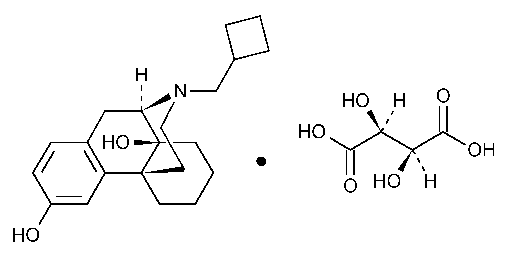Butorphanol Tartrate
Morphinan-3,14-diol,17-(cyclobutylmethyl)-,(-)-,[S-(R*,R*)]-2,3-dihydroxybutanedioate (1:1)(salt).
(-)-17-(Cyclobutylmethyl)morphinan-3,14-diol D-(-)-tartrate (1:1)(salt) [58786-99-5].
»Butorphanol Tartrate contains not less than 98.0percent and not more than 102.0percent of C21H29NO2·C4H6O6,calculated on the anhydrous basis.
Packaging and storage—
Preserve in tight containers.Store at 25 ,excursions permitted between 15
,excursions permitted between 15 and 30
and 30 .
.
Identification—
A:Infrared Absorption á197Kñ.
B:
TheRFvalue of the principal spot in the chromatogram of theTest preparation corresponds to that in the chromatogram of theStandard preparation,as obtained for testAin theChromatographic puritytest.
Specific rotation á781Sñ:
between -60 and -66
and -66 .
.
Test solution:
4mg per mL,in methanol.
Water,Method Iá921ñ:
not more than 2.0%.
Residue on ignition á281ñ:
not more than 0.1%.
Heavy metals,Method IIá231ñ:
0.003%.
Chromatographic purity—
METHOD A(Thin-Layer Chromatography)—
Standard solution—
Prepare a solution in methanol containing 1mg of USP Butorphanol Tartrate RSper mL.
Test solution—
Transfer 100mg of Butorphanol Tartrate to a 10-mLvolumetric flask.Dissolve in methanol,dilute with methanol to volume,and mix.
Iodoplatinate spray reagent—
Prepare a 1in 10solution of chloroplatinic acid in water.To 0.5mLof this solution add 33mLof water and 1g of potassium iodide to obtain the spray reagent.Prepare fresh daily.
Procedure—
Apply 50µLof theTest solution,containing 500µg of butorphanol tartrate,and 5µLand 10µLof theStandard solution,containing 5µg and 10µg of USP Butorphanol Tartrate RS,respectively,about 2cm apart to a line parallel to and about 2cm from the bottom of a thin-layer chromatographic plate (seeChromatography á621ñ)coated with a 0.25-mm layer of chromatographic silica gel mixture.Place the plate in a developing chamber containing,and equilibrated with,a mixture of chloroform,methanol,benzene,and ammonium hydroxide (85:25:20:5).Develop the chromatogram until the solvent front has moved about 10cm above the line of application.Remove the plate,mark the solvent front,and allow the solvent to evaporate.Spray the plate withIodoplatinate spray reagent.Estimate the percentage of the impurities present in theTest solutionby comparing the intensities of secondary spots,if present,with the intensities of the principal spots obtained from the chromatograms of theStandard solution.The sum of the impurities observed is not greater than 2.0%.
METHOD B(Gas Chromatography)—
Dissolve a suitable quantity of Butorphanol Tartrate in methanol to obtain a solution containing about 10mg per mL.Inject 1µLof this solution into a suitable gas chromatograph equipped with a flame-ionization detector and a 1.8-m ×4-mm glass column containing 3%liquid phase G3on support S1AB.The temperatures of the injection port,column,and detector are maintained at about 280 ,250
,250 ,and 290
,and 290 ,respectively.The carrier gas is nitrogen.Record a 30-minute chromatogram.Preferably using an electronic integrator,determine the areas of all peaks in the chromatogram excluding the area of the solvent.In a suitable chromatogram,the retention time for the alpha isomer of butorphanol tartrate is 1.2relative to 1.0for butorphanol tartrate;and the retention time of butorphanol tartrate is not less than 15minutes.Calculate the percentage of synthesis precursors in the test specimen by the formula:
,respectively.The carrier gas is nitrogen.Record a 30-minute chromatogram.Preferably using an electronic integrator,determine the areas of all peaks in the chromatogram excluding the area of the solvent.In a suitable chromatogram,the retention time for the alpha isomer of butorphanol tartrate is 1.2relative to 1.0for butorphanol tartrate;and the retention time of butorphanol tartrate is not less than 15minutes.Calculate the percentage of synthesis precursors in the test specimen by the formula:
100AV/AS,
in whichAVis the sum of the areas of all minor peaks;andASis the sum of the areas of the major and minor peaks.The limit is 2.0%.
Assay—
Dissolve about 500mg of Butorphanol Tartrate,accurately weighed,in 75mLof glacial acetic acid.Add crystal violet TS,and titrate with 0.1Nperchloric acid VS.Perform a blank determination,and make any necessary correction.Each mLof 0.1Nperchloric acid is equivalent to 47.76mg of C21H29NO2·C4H6O6.
Auxiliary Information—
Staff Liaison:Clydewyn M.Anthony,Ph.D.,Scientist
Expert Committee:(PA2)Pharmaceutical Analysis 2
USP28–NF23Page 310
Pharmacopeial Forum:Volume No.29(6)Page 1851
Phone Number:1-301-816-8139
